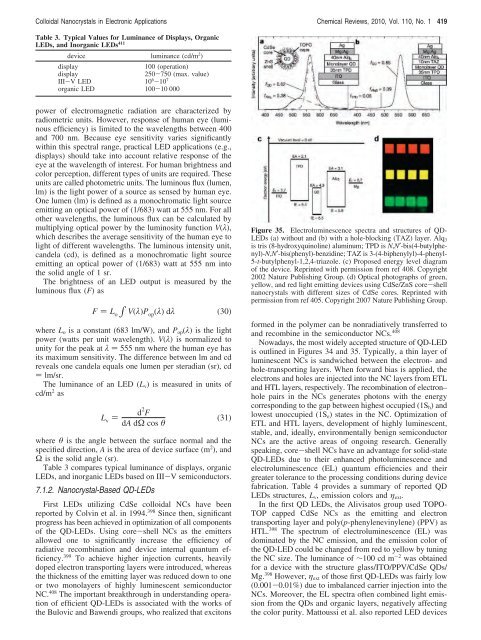Prospects of Colloidal Nanocrystals for Electronic - Computer Science
Prospects of Colloidal Nanocrystals for Electronic - Computer Science
Prospects of Colloidal Nanocrystals for Electronic - Computer Science
Create successful ePaper yourself
Turn your PDF publications into a flip-book with our unique Google optimized e-Paper software.
<strong>Colloidal</strong> <strong>Nanocrystals</strong> in <strong>Electronic</strong> Applications Chemical Reviews, 2010, Vol. 110, No. 1 419<br />
Table 3. Typical Values <strong>for</strong> Luminance <strong>of</strong> Displays, Organic<br />
LEDs, and Inorganic LEDs411 device luminance (cd/m2 )<br />
display 100 (operation)<br />
display 250-750 (max. value)<br />
III-V LED 106-107 organic LED 100-10 000<br />
power <strong>of</strong> electromagnetic radiation are characterized by<br />
radiometric units. However, response <strong>of</strong> human eye (luminous<br />
efficiency) is limited to the wavelengths between 400<br />
and 700 nm. Because eye sensitivity varies significantly<br />
within this spectral range, practical LED applications (e.g.,<br />
displays) should take into account relative response <strong>of</strong> the<br />
eye at the wavelength <strong>of</strong> interest. For human brightness and<br />
color perception, different types <strong>of</strong> units are required. These<br />
units are called photometric units. The luminous flux (lumen,<br />
lm) is the light power <strong>of</strong> a source as sensed by human eye.<br />
One lumen (lm) is defined as a monochromatic light source<br />
emitting an optical power <strong>of</strong> (1/683) watt at 555 nm. For all<br />
other wavelengths, the luminous flux can be calculated by<br />
multiplying optical power by the luminosity function V(λ),<br />
which describes the average sensitivity <strong>of</strong> the human eye to<br />
light <strong>of</strong> different wavelengths. The luminous intensity unit,<br />
candela (cd), is defined as a monochromatic light source<br />
emitting an optical power <strong>of</strong> (1/683) watt at 555 nm into<br />
the solid angle <strong>of</strong> 1 sr.<br />
The brightness <strong>of</strong> an LED output is measured by the<br />
luminous flux (F) as<br />
F ) L o∫V(λ)P op (λ) dλ (30)<br />
where Lo is a constant (683 lm/W), and Pop(λ) is the light<br />
power (watts per unit wavelength). V(λ) is normalized to<br />
unity <strong>for</strong> the peak at λ ) 555 nm where the human eye has<br />
its maximum sensitivity. The difference between lm and cd<br />
reveals one candela equals one lumen per steradian (sr), cd<br />
) lm/sr.<br />
The luminance <strong>of</strong> an LED (Lv) is measured in units <strong>of</strong><br />
cd/m 2 as<br />
L v )<br />
d 2 F<br />
dA dΩ cos θ<br />
(31)<br />
where θ is the angle between the surface normal and the<br />
specified direction, A is the area <strong>of</strong> device surface (m2 ), and<br />
Ω is the solid angle (sr).<br />
Table 3 compares typical luminance <strong>of</strong> displays, organic<br />
LEDs, and inorganic LEDs based on III-V semiconductors.<br />
7.1.2. Nanocrystal-Based QD-LEDs<br />
First LEDs utilizing CdSe colloidal NCs have been<br />
reported by Colvin et al. in 1994. 398 Since then, significant<br />
progress has been achieved in optimization <strong>of</strong> all components<br />
<strong>of</strong> the QD-LEDs. Using core-shell NCs as the emitters<br />
allowed one to significantly increase the efficiency <strong>of</strong><br />
radiative recombination and device internal quantum efficiency.<br />
399 To achieve higher injection currents, heavily<br />
doped electron transporting layers were introduced, whereas<br />
the thickness <strong>of</strong> the emitting layer was reduced down to one<br />
or two monolayers <strong>of</strong> highly luminescent semiconductor<br />
NC. 408 The important breakthrough in understanding operation<br />
<strong>of</strong> efficient QD-LEDs is associated with the works <strong>of</strong><br />
the Bulovic and Bawendi groups, who realized that excitons<br />
Figure 35. Electroluminescence spectra and structures <strong>of</strong> QD-<br />
LEDs (a) without and (b) with a hole-blocking (TAZ) layer. Alq3<br />
is tris (8-hydroxyquinoline) aluminum; TPD is N,N′-bis(4-butylphenyl)-N,N′-bis(phenyl)-benzidine;<br />
TAZ is 3-(4-biphenylyl)-4-phenyl-<br />
5-t-butylphenyl-1,2,4-triazole. (c) Proposed energy level diagram<br />
<strong>of</strong> the device. Reprinted with permission from ref 408. Copyright<br />
2002 Nature Publishing Group. (d) Optical photographs <strong>of</strong> green,<br />
yellow, and red light emitting devices using CdSe/ZnS core-shell<br />
nanocrystals with different sizes <strong>of</strong> CdSe cores. Reprinted with<br />
permission from ref 405. Copyright 2007 Nature Publishing Group.<br />
<strong>for</strong>med in the polymer can be nonradiatively transferred to<br />
and recombine in the semiconductor NCs. 408<br />
Nowadays, the most widely accepted structure <strong>of</strong> QD-LED<br />
is outlined in Figures 34 and 35. Typically, a thin layer <strong>of</strong><br />
luminescent NCs is sandwiched between the electron- and<br />
hole-transporting layers. When <strong>for</strong>ward bias is applied, the<br />
electrons and holes are injected into the NC layers from ETL<br />
and HTL layers, respectively. The recombination <strong>of</strong> electron–<br />
hole pairs in the NCs generates photons with the energy<br />
corresponding to the gap between highest occupied (1Sh) and<br />
lowest unoccupied (1Se) states in the NC. Optimization <strong>of</strong><br />
ETL and HTL layers, development <strong>of</strong> highly luminescent,<br />
stable, and, ideally, environmentally benign semiconductor<br />
NCs are the active areas <strong>of</strong> ongoing research. Generally<br />
speaking, core-shell NCs have an advantage <strong>for</strong> solid-state<br />
QD-LEDs due to their enhanced photoluminescence and<br />
electroluminescence (EL) quantum efficiencies and their<br />
greater tolerance to the processing conditions during device<br />
fabrication. Table 4 provides a summary <strong>of</strong> reported QD<br />
LEDs structures, Lv, emission colors and ηext.<br />
In the first QD LEDs, the Alivisatos group used TOPO-<br />
TOP capped CdSe NCs as the emitting and electron<br />
transporting layer and poly(p-phenylenevinylene) (PPV) as<br />
HTL. 398 The spectrum <strong>of</strong> electroluminescence (EL) was<br />
dominated by the NC emission, and the emission color <strong>of</strong><br />
the QD-LED could be changed from red to yellow by tuning<br />
the NC size. The luminance <strong>of</strong> ∼100 cd m -2 was obtained<br />
<strong>for</strong> a device with the structure glass/ITO/PPV/CdSe QDs/<br />
Mg. 398 However, ηext <strong>of</strong> those first QD-LEDs was fairly low<br />
(0.001-0.01%) due to imbalanced carrier injection into the<br />
NCs. Moreover, the EL spectra <strong>of</strong>ten combined light emission<br />
from the QDs and organic layers, negatively affecting<br />
the color purity. Mattoussi et al. also reported LED devices
















